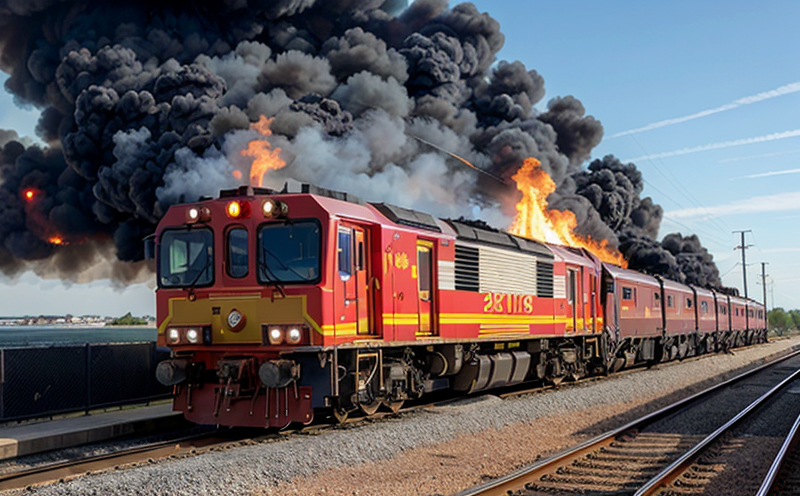Simulation of Fire Scenarios in Railway Carriages
The simulation of fire scenarios in railway carriages is a critical aspect of ensuring the safety and compliance of transport systems with international standards. This service involves the reproduction of realistic fire conditions to evaluate the performance of materials, structures, and systems within railway carriages. By understanding how these elements behave under actual fire conditions, manufacturers can design more robust and safer vehicles.
The process begins by selecting appropriate test specimens that represent key components such as seating upholstery, insulation materials, and electrical wiring. These specimens are then subjected to controlled combustion tests using various ignition sources and environments designed to mimic real-world fire scenarios. The primary objective is to assess the extent of damage, smoke production, heat release rates, and structural integrity during these simulations.
Real-world data plays a crucial role in this process. Historical incidents involving fires on railways provide invaluable insights into potential hazards and vulnerabilities. Incorporating this information helps refine test protocols and improve predictive models for future safety improvements. Compliance with relevant international standards like ISO 16724, ASTM E84-19, and EN 458-3 ensures that the testing methodology is both rigorous and internationally recognized.
The use of advanced instrumentation enhances the accuracy and reliability of test results. High-speed cameras capture detailed images throughout the combustion process, while gas analyzers measure emissions such as carbon monoxide (CO) and nitrogen dioxide (NO₂). Thermal imaging systems provide non-contact temperature readings, which are vital for assessing heat distribution patterns around the fire source.
Post-test analysis involves reviewing all collected data to identify areas where improvements can be made. Reports generated from these analyses serve multiple purposes: guiding manufacturers in selecting safer materials; informing regulatory bodies about necessary amendments to existing standards; and supporting insurance companies in setting appropriate premiums based on risk assessments derived from the tests.
- Realistic Fire Conditions: Reproduction of actual fire conditions using controlled environments and ignition sources.
- Data Collection: Utilization of high-speed cameras, gas analyzers, thermal imaging systems, etc., to gather comprehensive data during the test.
- Compliance Verification: Ensuring adherence to international standards such as ISO 16724, ASTM E84-19, and EN 458-3.
In summary, simulating fire scenarios in railway carriages is an essential component of comprehensive safety measures. It allows for proactive identification of potential risks early on, enabling manufacturers to implement preventive actions before incidents occur. This approach not only enhances passenger safety but also contributes significantly towards meeting stringent regulatory requirements across different jurisdictions.
Applied Standards
The simulation of fire scenarios in railway carriages must adhere strictly to established international standards that govern material flammability and structural integrity under adverse conditions. Compliance with these standards ensures consistency, reliability, and safety across diverse operating environments. Some key standards include:
- ISO 16724: This standard specifies the test methods for determining the flame spread index of materials used in railway carriages. It helps evaluate how quickly flames can spread along a material surface and assesses its resistance to ignition.
- ASTM E84-19: Known as the Steiner Tunnel Test, this standard defines procedures for measuring smoke production and flame spread characteristics of materials used in interior furnishings. It provides valuable information about the potential impact on fire safety systems like sprinklers and smoke detectors.
- EN 458-3: This European harmonized standard covers the requirements for fire protection of railway vehicles, including structural components and passenger seating areas. It ensures that all parts contribute effectively to reducing casualties during a fire emergency.
By adhering to these standards, laboratories like Eurolab can provide accurate and consistent test results that are universally accepted by regulators worldwide.
Eurolab Advantages
At Eurolab, our commitment to excellence in fire safety testing extends beyond mere compliance with international standards. We offer a range of unique advantages tailored specifically for clients involved in marine and railway transportation sectors:
- State-of-the-Art Facilities: Our laboratories are equipped with cutting-edge equipment capable of simulating various fire scenarios under controlled conditions.
- Expertise and Experience: Our team comprises highly skilled professionals with extensive experience in conducting comprehensive evaluations for different types of materials and systems.
- Customized Solutions: We understand that each project has its own unique requirements. Therefore, we offer flexible solutions designed to meet individual client needs efficiently.
Our approach combines scientific rigor with practical applicability, ensuring that every aspect of the testing process is meticulously executed. This comprehensive methodology guarantees accurate and reliable results, thereby enhancing overall product quality and safety.





